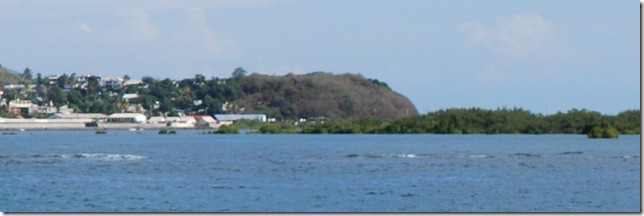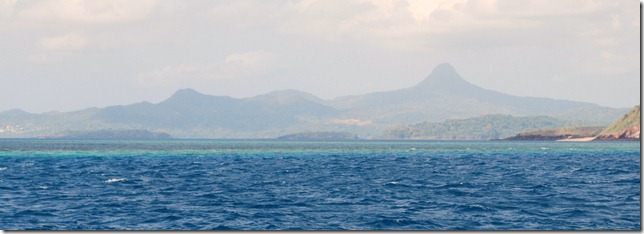Lat: 13 44.681′ S
Long: 43 44.363′ E
We’re back at it again, ticking off the miles toward Mozambique. Our stay in Mayotte was short but productive, and Pura Vida’s in much better shape now than when she arrived there. The part that we needed arrived on schedule on Monday and turned out to be the correct one. Dallas tensioned up the rigging to his satisfaction, and we are currently sailing on it with both the main and the jib.
We did a lot of walking in our 5 days in Mayotte, but Monday took the cake. We walked from end to end of the island taking care of last-day chores, mostly related to clearing out. The port captain, customs, and immigration officials need to be visited in their respective offices, and putting them all in one place would be far too sensible for the French. Then around 2:00 in the afternoon, the electricity went out. (We later learned that it was a nationwide problem, meaning that it was out on the big island as well.) We hadn’t considered the implications of this for our check-out paperwork as we were walking back to the port captain’s office, but Ronan, the port captain, happened to ride by on his scooter and informed us that he coud not print our clearance papers. However, he told us in his broken English (much better than our French!) that he could probably use the Navy’s generator-powered computer and assured us, "I try my maximum!" He was by far the friendliest person that we met on the island and seemed invested in his role as a public servant.
Another example of this was Ronan’s consultation with us about piracy. He told us the Somali pirates were thought to have hijacked a cruising boat near Dar Es Salaam (Tanzania) last week and showed us photos of the yacht in an effort to get more info about it. He acknowledged that the pirates had not come as far south as Mayotte but encouraged us to put his phone number in our satellite phone just in case, as he is only a phone call away from the French Navy based there in Mayotte. Needless to say, we now have Ronan on our speed dial.
However, there’s no need to worry! (Do you hear that, Mom?!) As I write, we are almost 100 miles southwest of Mayotte and are steadily increasing our pirate buffer zone. But I would be lying if I said we didn’t have pirates on the brain yesterday as we left Mayotte. I devised a couple of hair-brained schemes for what we might do if we saw them approaching (apart from calling Ronan and setting off our Personal Locator Beacon (PLB)), one involving scuba gear. Dallas wasn’t opposed to either of them but reminded me that we aren’t Green Berets or action movie heroes and might have trouble actually pulling it off. I guess we’ll just stick to the plan and stay out of their way!
The GRIB data had predicted very light northerly winds for departure from Mayotte, and that’s exactly what we got. The sea was smooth as silk as we motored along, and we spotted a few small whale tails in the distance. We had read in another blog that whales here in the Channel sometimes appear to be standing on their head for several minutes, and that is exactly what it looked like! In the absence of wind, it was over 90 degrees in the salon but pretty pleasant in the cockpit, prompting Dallas to make up a bed on deck under a sky full of stars. The wind picked up around 2:00 a.m., allowing us to sail under the jib, and we hoisted the main around 3:00 when Dallas got up for his watch. With any luck, we’ll continue to sail the remaining 188 miles to Ilha Mozambique.
So far, our stop in Mayotte has been productive, but we haven’t had much time for being tourists. Our first few days have been spent checking in, provisioning, knocking out the list of required boat repairs, updating the website, doing 5 weeks of laundry (not as much as you’d think with four of the weeks spent offshore), and jugging diesel and water to fill the tanks. The part for the rigging arrived at the airport on Friday, but won’t clear customs until today (Monday), so we’re planning to check out today, hope it fits, and leave on Tuesday morning. We’d love to stay longer and explore a bit, but we’re getting reminders that it’s time to be moving along. The first tropical disturbance and cyclone of the season have both occurred already. We were just in time to pass ahead of the tropical disturbance as we crossed the Indian Ocean, and the first cyclone was behind us as well, nearly hitting Cocos Keeling several weeks after we left. With the SW monsoon ending, the Somali pirates are moving south as well. Last week they captured a vessel en route from Tanzania to the Comoros, of which Mayotte is a disputed part. They’re still north of us, but the 200-mile buffer zone I’d planned to keep between us and any known Somali pirate attack is shrinking this year, made smaller by our stop in Mayotte, and really doesn’t seem like a lot once you’re here.
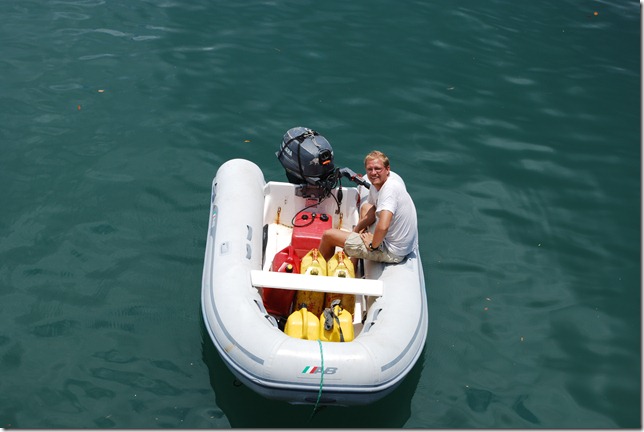 Bringing the diesel jugs in to the fuel station atop a rocky wharf
Bringing the diesel jugs in to the fuel station atop a rocky wharf
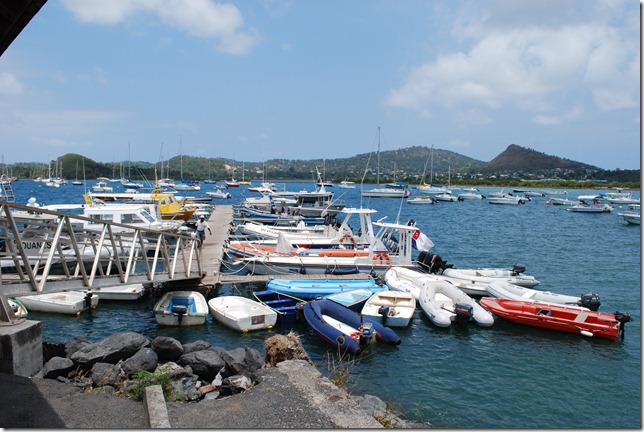 The finger pier used by dinghies wobbles so much that it seems like a water park gizmo meant to get you wet
The finger pier used by dinghies wobbles so much that it seems like a water park gizmo meant to get you wet
We’re getting a heavy rain this morning, which, along with the hot days of light wind is yet another sign of the changing monsoon. The Indian Ocean is different from the Atlantic and Pacific in that the North Indian Ocean is a “two-way” ocean subject to monsoons (from the Arabic word for fixed seasons). The prevailing wind direction in the North Indian Ocean changes from SW (May to October) to NE (November to March) annually, with the SW monsoon generally bringing more rain, and the transition between monsoons being a period of light winds and heavy rainstorms. The North Indian Ocean monsoons have been useful for sailors for centuries because they let you sail downwind across the ocean in both directions if you time your passage for the proper monsoon. Our current location in the northern part of the South Indian ocean at the end of the SW monsoon means that the trades in the area will be pushed south and replaced by the doldrums and squalls of the ITCZ in the next couple of months as it makes its yearly migration to the south accompanying the NE monsoon.
The anchorage here in Dzaoudzi is an interesting one. It’s about 50 feet deep, which is OK for anchoring, but you’d want to put out at least 200’ of chain, which means you’d need quite a distance between you and adjacent boats to avoid swinging into each other. Moorings have been laid instead, as there are a lot of French live-aboard boats here. Unfortunately, the moorings haven’t been planned very well and many leave boats within swinging distance of each other. Last night, with the very light winds and strange currents here, we bumped the boat next to us and saw other boats fending off as well. We were lucky to find an open mooring whose owner let us stay here for free. The other interesting thing about this mooring is the tidal lake beside it. At high tide, water from the lagoon flows into the lake, and at low tide the edge of the lake is like a waterfall, with rivers of water cascading into the anchorage. It makes a fun place for local kids to play, and the current is one of the reasons that the boats end up in odd orientations here. At the edge of the anchorage is the Blue Water Cruising Association of Mayotte. It would fall into the generally category of “yacht club” but is really more of a glorified boatyard serving the numerous French sailors that live aboard on moorings and on the hard. The bar is actually a shipping container with a service window cut in the side that is lifted with a sailing block and line in the morning and then dropped and locked at night. It is only approachable by dinghy during the upper half of the tide, but that timing has worked out well for us during our stay. Tide has been high right around shower time. We’ve enjoyed a couple of the refreshing cold water showers with a knob that you push to get about 5 seconds of water, just like the knobs on water-conserving sinks in public restrooms in the US.
 Local kids playing in the waterfalls created by the tidal lake
Local kids playing in the waterfalls created by the tidal lake
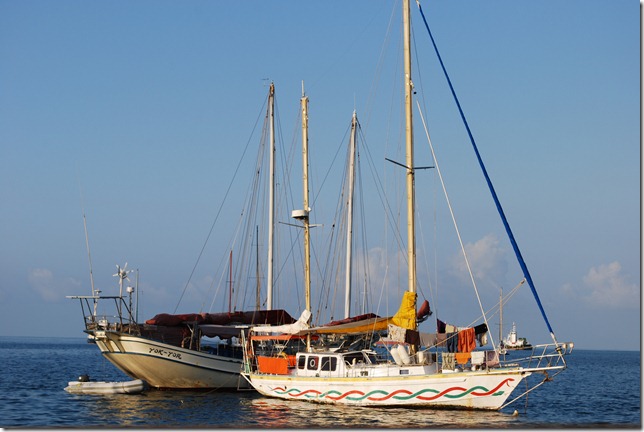 Two boats doing the Dzaoudzi light wind tango
Two boats doing the Dzaoudzi light wind tango
We have managed to avail ourselves of one of the French luxuries that Wes introduced me to – bread, cheese & wine. The French territories always have fresh baguettes, and the boulangeries here make an excellent assortment of fresh bread daily. The cheese selection in the supermarket, which is usually very limited in remote places, would rival an upscale US grocery store, and the wine selection is unusually diverse and cheap, with numerous French and South African selections. We were snacking on bread and cheese at the “yacht club” yesterday evening when I commented on the good cheese to one of the friendly Frenchman who’d come over to visit with us. He took a look at our selection and grunted with a disinterested air, “Hmmm, cooking cheese.” Ahh the French. We’d forgotten about the unique and numerous mannerisms they have. I can’t really think of a parallel in the US for the characteristic French hand gestures and facial expressions that often accompany or substitute for common descriptive expressions.
The combined cyclone risk and virtual guarantee of a southerly ‘buster’ or two that will make for dangerous wave states when it opposes the strong southerly current may make the passage from here to South Africa one of our tougher ones. If the weather cooperates, we’re planning to move south as quickly as possible until we get to the south part of the Mozambique channel where the busters are common. From there to South Africa, we’ll try to move when the winds are good and duck into an anchorage in Mozambique when the winds come from the south. Once we get closer to Mozambique, we should be in the south-setting Mozambique current while we’re moving, which will give us a boost.
Now if only the downpour would stop so we can run our final errands without getting soaked…
Approaching Mayotte was pretty exciting. For the first time in 24 night watches, I had no trouble staying awake until 3 a.m. The wind freshened quite a bit, and in order to avoid putting strain on the rigging, I furled the jib a few times until we were going 4+ knots with just a bit of sail. I could see the glow of civilization on the horizon in the otherwise black night from about 30 miles out, which was quite different from the single point of light that could be seen from Madagascar at night. Then it was time for one last short night of sleep.
By the time I arose, Dallas had already navigated through the large pass into the lagoon. We agreed that the landscape is reminiscent of the Society Islands in French Polynesia. They seem to fit Earl Hinz’ (author of “Landfalls of the Pacific”) definition of an “almost atoll” – the volcanic islands have started to recede into the sea, leaving just the peaks exposed in the midst of the lagoon. Surrounding the lagoon is limestone reef that emerged from the earth’s crust as the volcanoes sank. Here in Mayotte there is one main island (Grand Terre), a smaller one where we are moored (Petite Terre), and a number of very small, uninhabited islands, some of which have beautiful white sand beaches.
The mishaps began when we approached the mooring field. I generally work the bow while Dallas is at the helm, and I had the bridle in place in preparation to anchor. However, the area turned out to be too deep and full of boats for anchoring, so I quickly located our mooring line in the bottom of the sail locker and replaced the bridle set-up. Dallas motored us up to the mooring into the strong wind and swell. I got hold of the buoy with the boat hook but didn’t drag it up and get our line through it fast enough, and before I knew it, the mooring was under the boat with the boat hook attached. The boat hook is pretty important to my work at the bow, so I hopped in the water to retrieve it, swam back to the transom to get on board, and returned to the bow for round two.
This time I was able to pull up the buoy and get our line through, but I put it through a loop of weak rope instead of the thick and sturdy one underneath the large but very heavy buoy. Dallas told me we needed to try again, but I couldn’t get our line free. It was stuck on the buoy. I was afraid the free end of our line was going to end up wrapped around our propeller, which would not make for a good day, so I hopped in the water again! Once in the water, getting the line free was easy, but getting back to the boat in the midst of the strong current was not. Despite the communication problems during this incident (the noise of the wind and the need for quick action made it tough), Dallas decided he wanted to retrieve me and spun the boat around to pick me up. Eventually I made it back on board, and we decided to give it a go again (what choice did we have?!). This time I took the helm, we chose a different buoy, and Dallas was able to pull it up and get us secured to it. Third time’s a charm.
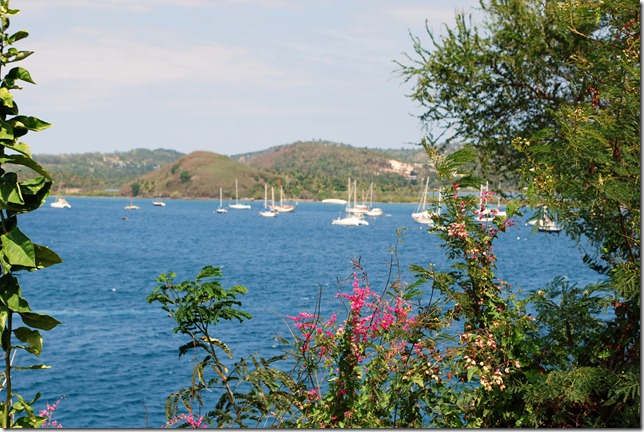 A pretty picture once safely secured on the mooring
A pretty picture once safely secured on the mooring
Speaking of which, I ended up in the water for yet a third time yesterday. It happened that evening after we had returned from taking a walking tour around the island and enjoying some cold beer and pizza. (I guess beer took precedence over salad, although we found a pretty good market and had some salad that evening on the boat.) We had read in other cruisers’ blogs that, at least in 2008, there was quite a bit of crime in Mayotte, and dinghies/outboard engines were commonly stolen. The manager of the yacht club told us it hadn’t happened for a while but suggested that we not stow our outboard behind the boat just in case. We agreed that there’s no point in taking chances with such vital gear, so for the first time ever, we decided to bring it inside the boat at night. With our 15-horsepower, 4-stroke outboard, this is not the easiest of tasks – at least not the first time. We hoisted it up without too much trouble, but in doing so, the cover came off and started floating away. Dallas, who was holding the outboard in place on the boat, shouted, “get it!” So I found myself in the murky water once again. I went through as many clothes yesterday as I did in one week offshore!
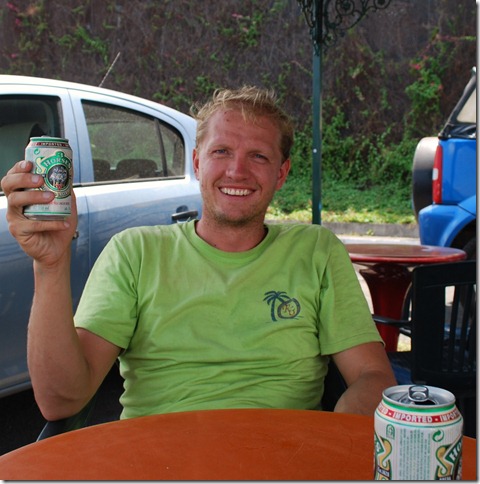 Civilization has its merits such as Three Horses Beer (called “Tay-Hash-Bay”, French for T.H.B.)
Civilization has its merits such as Three Horses Beer (called “Tay-Hash-Bay”, French for T.H.B.)
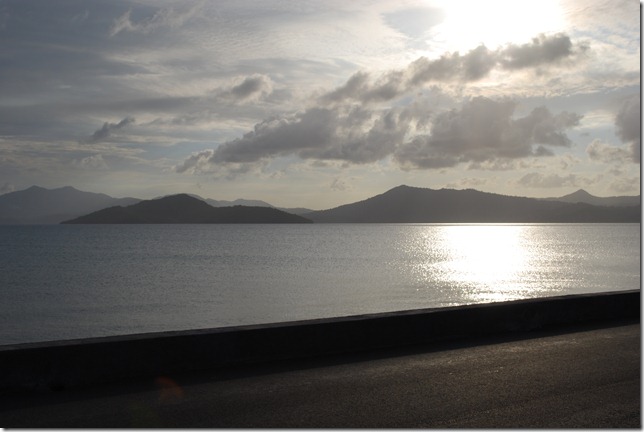 No shortage of natural beauty here either
No shortage of natural beauty here either
Despite the mishaps and potential for crime, it has been a most welcome change to be in the vicinity of land, and a new continent at that! The French presence is very strong here, with French gendarmes (police), French Foreign Legion, and expats visible everywhere we’ve been, but the Mayotte people are still very much African. They are well dressed in colorful sarongs (women) and headwear (men and women) and seem to carry themselves with pride. Some of the women paint their face with an off-white makeup, and I have yet to find out why – just having simple conversations in French has been pretty challenging so far, so we’ll see how it goes!
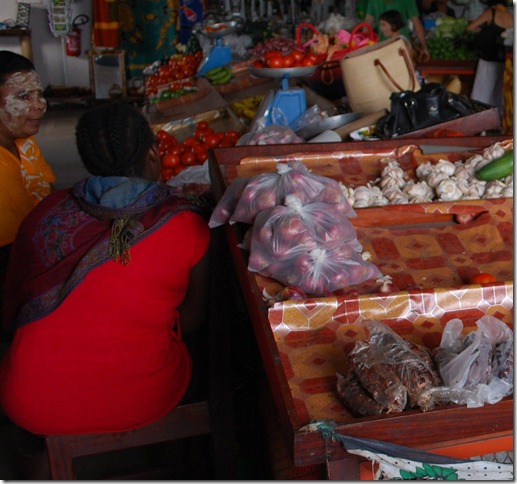 See the face painting – mais pourquoi?!
See the face painting – mais pourquoi?!
It has been pretty full on since we’ve been here – clearing in, getting our bearings, provisioning, taking advantage of internet, etc., but we are going to enjoy some French wine and cheese and a good night’s sleep tonight.


